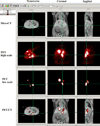In vivo micro-CT imaging of liver lesions in small animal models
- PMID: 19520168
- PMCID: PMC2818035
- DOI: 10.1016/j.ymeth.2009.05.016
In vivo micro-CT imaging of liver lesions in small animal models
Abstract
Three-dimensional micro computed tomography (microCT) offers the opportunity to capture images liver structures and lesions in mice with a high spatial resolution. Non-invasive microCT allows for accurate calculation of vessel tortuosity and density, as well as liver lesion volume and distribution. Longitudinal monitoring of liver lesions is also possible. However, distinguishing liver lesions from variations within a normal liver is impossible by microCT without the use of liver- or tumor-specific contrast-enhancing agents. The combination of microCT for morphologic imaging with functional imaging, such as positron emission tomography (PET) or single photon emission tomography (SPECT), offers the opportunity for better abdominal imaging and assessment of structure discrepancies visible by functional imaging. This paper describes methods of current microCT imaging options for imaging of liver lesions compared to other imaging techniques in small animals.
Published by Elsevier Inc.
Figures



References
Publication types
MeSH terms
Substances
Grants and funding
LinkOut - more resources
Full Text Sources
Other Literature Sources
Medical

